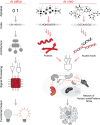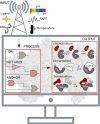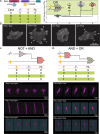Autonomous Nucleic Acid and Protein Nanocomputing Agents Engineered to Operate in Living Cells
- PMID: 39760461
- PMCID: PMC11757000
- DOI: 10.1021/acsnano.4c13663
Autonomous Nucleic Acid and Protein Nanocomputing Agents Engineered to Operate in Living Cells
Abstract
In recent years, the rapid development and employment of autonomous technology have been observed in many areas of human activity. Autonomous technology can readily adjust its function to environmental conditions and enable an efficient operation without human control. While applying the same concept to designing advanced biomolecular therapies would revolutionize nanomedicine, the design approaches to engineering biological nanocomputing agents for predefined operations within living cells remain a challenge. Autonomous nanocomputing agents made of nucleic acids and proteins are an appealing idea, and two decades of research has shown that the engineered agents act under real physical and biochemical constraints in a logical manner. Throughout all domains of life, nucleic acids and proteins perform a variety of vital functions, where the sequence-defined structures of these biopolymers either operate on their own or efficiently function together. This programmability and synergy inspire massive research efforts that utilize the versatility of nucleic and amino acids to encode functions and properties that otherwise do not exist in nature. This Perspective covers the key concepts used in the design and application of nanocomputing agents and discusses potential limitations and paths forward.
Keywords: directed evolution; nanocomputing agents; nucleic acid nanoparticles; proteins; rational design.
Conflict of interest statement
The authors declare no competing financial interest.
Figures





Similar articles
-
Planning Implications Related to Sterilization-Sensitive Science Investigations Associated with Mars Sample Return (MSR).Astrobiology. 2022 Jun;22(S1):S112-S164. doi: 10.1089/AST.2021.0113. Epub 2022 May 19. Astrobiology. 2022. PMID: 34904892
-
Aptamers as Modular Components of Therapeutic Nucleic Acid Nanotechnology.ACS Nano. 2019 Nov 26;13(11):12301-12321. doi: 10.1021/acsnano.9b06522. Epub 2019 Nov 5. ACS Nano. 2019. PMID: 31664817 Free PMC article. Review.
-
Bilingual Peptide Nucleic Acids: Encoding the Languages of Nucleic Acids and Proteins in a Single Self-Assembling Biopolymer.J Am Chem Soc. 2019 Dec 4;141(48):19038-19047. doi: 10.1021/jacs.9b09146. Epub 2019 Nov 21. J Am Chem Soc. 2019. PMID: 31711285
-
Cracking the Code: Enhancing Molecular Tools for Progress in Nanobiotechnology.ACS Appl Bio Mater. 2024 Jun 17;7(6):3587-3604. doi: 10.1021/acsabm.4c00432. Epub 2024 Jun 4. ACS Appl Bio Mater. 2024. PMID: 38833534 Free PMC article. Review.
-
Concept and Development of Algebraic Topological Framework Nucleic Acids.Chempluschem. 2024 Jul;89(7):e202300760. doi: 10.1002/cplu.202300760. Epub 2024 Apr 18. Chempluschem. 2024. PMID: 38529703
Cited by
-
Nucleic acid nanobiosystems for cancer theranostics: an overview of emerging trends and challenges.Nanomedicine (Lond). 2025 Jun;20(11):1281-1298. doi: 10.1080/17435889.2025.2501919. Epub 2025 May 6. Nanomedicine (Lond). 2025. PMID: 40326805 Review.
-
Optogenetic enzymes: A deep dive into design and impact.Curr Opin Struct Biol. 2025 Aug 5;94:103126. doi: 10.1016/j.sbi.2025.103126. Online ahead of print. Curr Opin Struct Biol. 2025. PMID: 40769055 Review.
-
The Evolving Landscape of Protein Allostery: From Computational and Experimental Perspectives.J Mol Biol. 2025 Mar 4:169060. doi: 10.1016/j.jmb.2025.169060. Online ahead of print. J Mol Biol. 2025. PMID: 40043838 Review.
References
-
- Ezenkwu C. P.; Starkey A. In Machine Autonomy: Definition, Approaches, Challenges and Research Gaps, Intelligent Computing; Arai K.; Bhatia R.; Kapoor S., Eds.; Springer International Publishing: Cham, 2019; pp 335–358.
-
- Abramson J. S.; Palomba M. L.; Gordon L. I.; Lunning M. A.; Wang M.; Arnason J.; Mehta A.; Purev E.; Maloney D. G.; Andreadis C.; Sehgal A.; Solomon S. R.; Ghosh N.; Albertson T. M.; Garcia J.; Kostic A.; Mallaney M.; Ogasawara K.; Newhall K.; Kim Y.; Li D.; Siddiqi T. Lisocabtagene maraleucel for patients with relapsed or refractory large B-cell lymphomas (TRANSCEND NHL 001): a multicentre seamless design study. Lancet 2020, 396 (10254), 839–852. 10.1016/S0140-6736(20)31366-0. - DOI - PubMed
-
- Munshi N. C.; Anderson L. D. Jr.; Shah N.; Madduri D.; Berdeja J.; Lonial S.; Raje N.; Lin Y.; Siegel D.; Oriol A.; Moreau P.; Yakoub-Agha I.; Delforge M.; Cavo M.; Einsele H.; Goldschmidt H.; Weisel K.; Rambaldi A.; Reece D.; Petrocca F.; Massaro M.; Connarn J. N.; Kaiser S.; Patel P.; Huang L.; Campbell T. B.; Hege K.; San-Miguel J. Idecabtagene Vicleucel in Relapsed and Refractory Multiple Myeloma. N Engl J. Med. 2021, 384 (8), 705–716. 10.1056/NEJMoa2024850. - DOI - PubMed
-
- Locatelli F.; Thompson A. A.; Kwiatkowski J. L.; Porter J. B.; Thrasher A. J.; Hongeng S.; Sauer M. G.; Thuret I.; Lal A.; Algeri M.; Schneiderman J.; Olson T. S.; Carpenter B.; Amrolia P. J.; Anurathapan U.; Schambach A.; Chabannon C.; Schmidt M.; Labik I.; Elliot H.; Guo R.; Asmal M.; Colvin R. A.; Walters M. C. Betibeglogene Autotemcel Gene Therapy for Non-beta(0)/beta(0) Genotype beta-Thalassemia. N Engl J. Med. 2022, 386 (5), 415–427. 10.1056/NEJMoa2113206. - DOI - PubMed
Publication types
MeSH terms
Substances
Grants and funding
LinkOut - more resources
Full Text Sources

